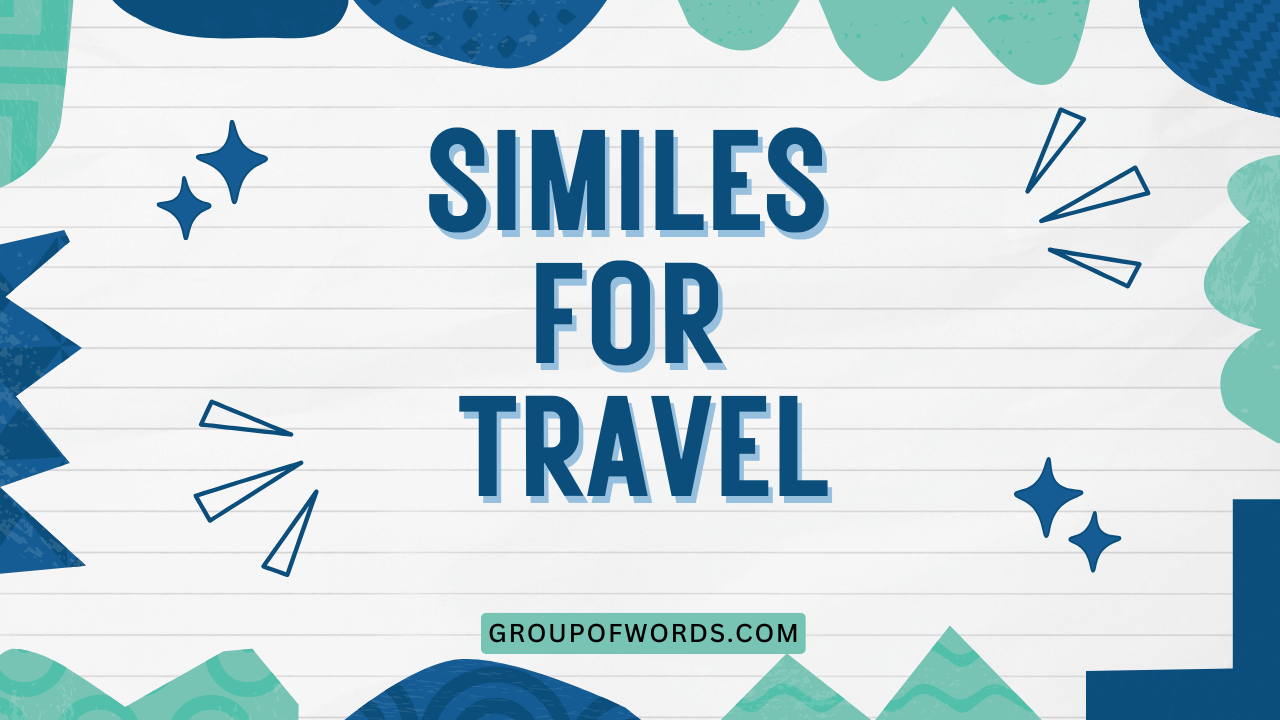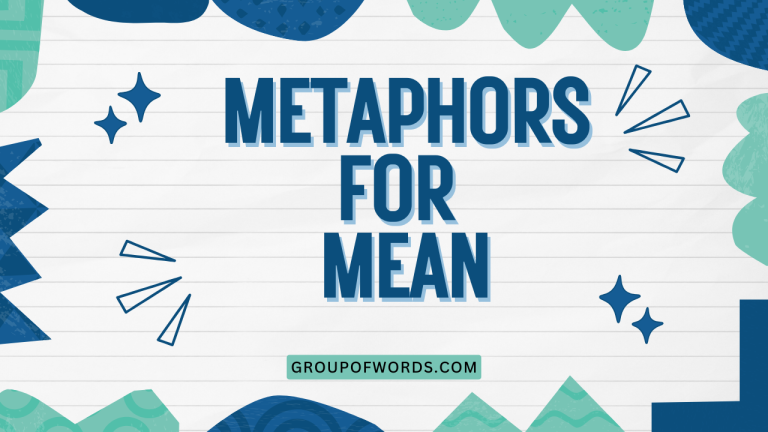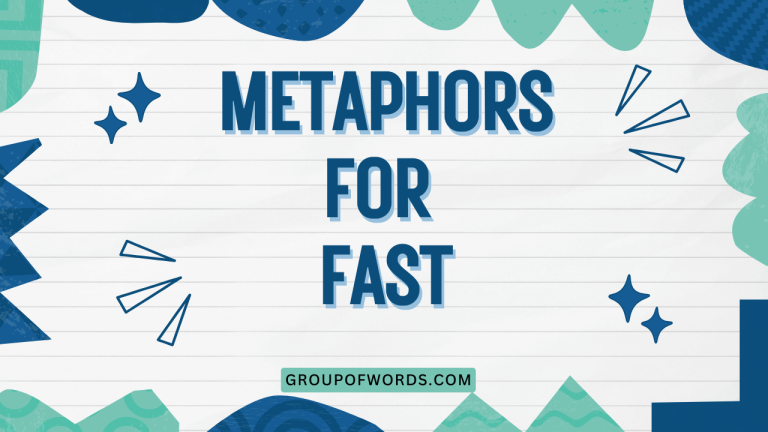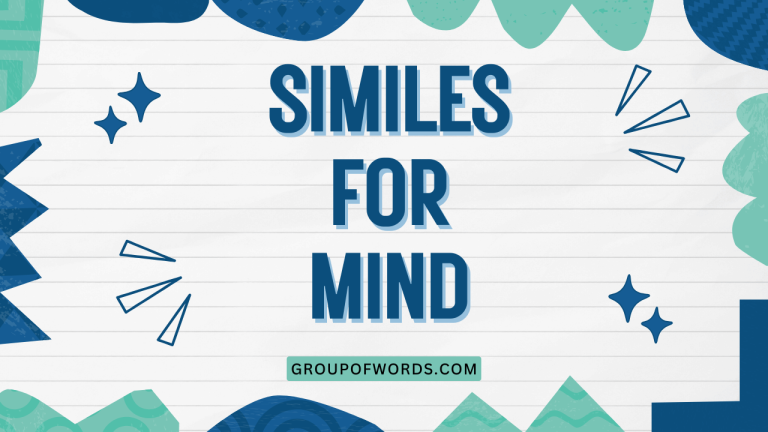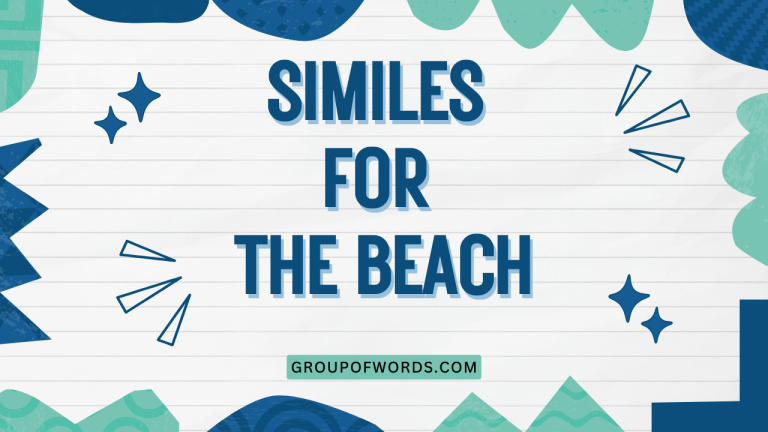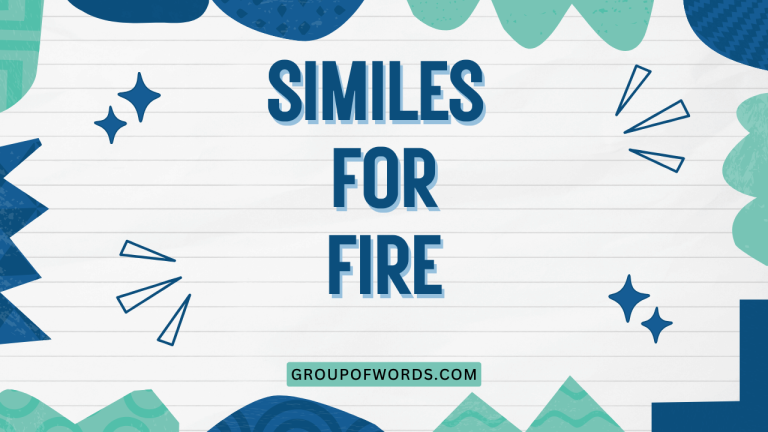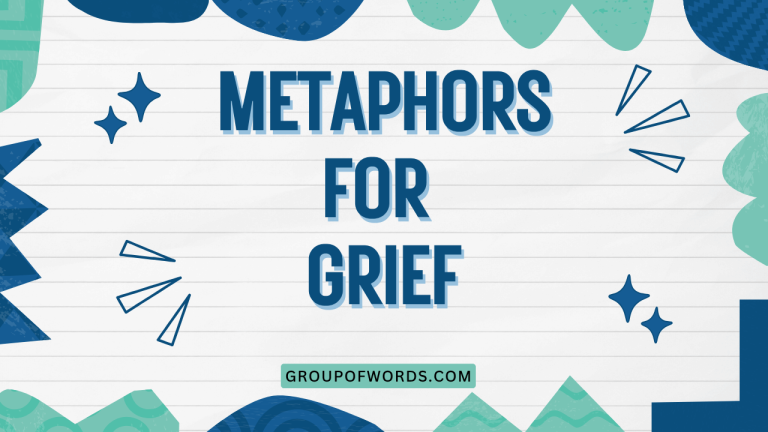Similes for Travel: A Grammatical Journey
Understanding similes is crucial for enhancing descriptive writing and adding vivid imagery to your language. Similes, a type of figurative language, allow us to compare different things using “like” or “as,” creating a more engaging and relatable experience for the reader.
This article will explore the world of similes specifically used in the context of travel, providing a comprehensive guide for anyone looking to improve their writing or simply appreciate the beauty of language. Whether you’re a student, a writer, or an English language learner, this article will equip you with the knowledge and tools to master similes in your travel narratives.
Table of Contents
- Definition of Similes
- Structural Breakdown of Similes
- Types of Similes
- Examples of Similes for Travel
- Usage Rules for Similes
- Common Mistakes with Similes
- Practice Exercises
- Advanced Topics: Nuances of Similes
- Frequently Asked Questions
- Conclusion
Definition of Similes
A simile is a figure of speech that directly compares two different things using the words “like” or “as.” The purpose of a simile is to create a vivid image or convey a specific feeling by drawing a connection between two seemingly unrelated concepts. Unlike metaphors, which state that one thing *is* another, similes suggest a similarity.
Similes are a powerful tool in writing, allowing authors to add depth, color, and emotional resonance to their descriptions. They make abstract ideas more concrete and relatable by linking them to familiar experiences.
In the context of travel writing, similes can bring the journey to life. They can describe the speed of a train, the comfort of a hotel room, the beauty of a landscape, or the emotional impact of an experience.
By using similes effectively, writers can transport their readers to the destination and make them feel like they are experiencing the journey firsthand.
Structural Breakdown of Similes
The basic structure of a simile consists of three main components: the topic, the vehicle, and the linking word. The topic is the subject being described, the vehicle is what the topic is being compared to, and the linking word is either “like” or “as.” Understanding these components is essential for constructing effective and meaningful similes.
For example, in the simile “The train moved like a rocket,” the topic is “the train,” the vehicle is “a rocket,” and the linking word is “like.” This structure clearly draws a comparison between the train’s speed and the speed of a rocket. Let’s break down the structure further with more examples related to travel.
Here’s a table that breaks down the structure of a few more similes:
| Simile | Topic | Linking Word | Vehicle |
|---|---|---|---|
| The mountains stood as silent sentinels. | The mountains | as | silent sentinels |
| The bus was packed like a sardine can. | The bus | like | a sardine can |
| The journey felt like a dream. | The journey | like | a dream |
| The desert stretched out as far as the eye could see. | The desert | as | far as the eye could see |
| The city lights twinkled like diamonds. | The city lights | like | diamonds |
Types of Similes
While all similes use “like” or “as” to make a comparison, they can be categorized based on the type of comparison they make. Some similes focus on physical attributes, while others highlight emotional or abstract qualities.
Understanding these different types can help you create more nuanced and effective descriptions.
Descriptive Similes
Descriptive similes focus on physical attributes, such as size, shape, color, or texture. They aim to paint a vivid picture in the reader’s mind by comparing the subject to something with similar physical characteristics.
For example, “The beach stretched out like a golden ribbon” uses the physical attribute of color and shape to describe the beach.
Emotional Similes
Emotional similes compare the subject’s emotional state to something else, conveying feelings of happiness, sadness, fear, or excitement. These similes often use abstract concepts or relatable experiences to evoke a specific emotion in the reader.
For instance, “The anticipation of the trip was like a bubbling excitement” connects the anticipation to the feeling of bubbling excitement.
Action Similes
Action similes describe the way something moves or behaves by comparing it to a similar action. These similes can add dynamism and energy to your writing, making the scene more engaging for the reader.
For example, “The train sped through the countryside like a bullet” uses the action of a bullet to describe the train’s speed.
Abstract Similes
Abstract similes compare intangible qualities or concepts, such as freedom, peace, or adventure, to other abstract ideas or concrete objects. These similes offer a deeper, more philosophical perspective on the subject, inviting the reader to contemplate the underlying meaning.
For example, “The feeling of wanderlust was like an unquenchable thirst” uses the abstract concept of thirst to describe the feeling of wanderlust.
Examples of Similes for Travel
Here are numerous examples of similes categorized to help you grasp their usage in different contexts of travel writing. Each category focuses on a specific aspect of the travel experience, providing a wide range of options for your own writing.
Similes for Speed of Travel
Describing speed is crucial when narrating a journey. Similes can make the experience more vivid and relatable.
Here are some examples of similes that describe the speed of travel, comparing various modes of transportation to fast-moving objects or animals.
The following table provides examples of similes that relate to the speed of travel. It includes the simile, the topic being described, and an explanation of the comparison.
| Simile | Topic | Explanation |
|---|---|---|
| The train sped along the tracks like a bullet. | Train | Compares the train’s speed to the rapid motion of a bullet. |
| The plane soared through the sky as fast as a falcon. | Plane | Compares the plane’s speed to the swiftness of a falcon in flight. |
| The car zoomed down the highway like a race car. | Car | Relates the car’s speed to that of a high-speed race car. |
| The boat skimmed across the water like a skipping stone. | Boat | Compares the boat’s movement to the quick, light motion of a skipping stone. |
| The bicycle flew down the hill as quick as a dart. | Bicycle | Relates the bicycle’s speed to the swiftness of a dart. |
| The jet took off like a rocket. | Jet | Compares the jet’s acceleration to the powerful launch of a rocket. |
| The ferry cut through the waves like a knife. | Ferry | Describes the ferry’s movement as sharp and fast, like a knife cutting. |
| The subway train roared through the tunnel like thunder. | Subway train | Relates the train’s speed and sound to the force of thunder. |
| The motorcycle zipped through traffic like a bee. | Motorcycle | Compares the motorcycle to the quick and agile movement of a bee. |
| The hot air balloon drifted as slow as a snail. | Hot air balloon | A contrast; compares the balloon’s slow pace to a snail. |
| The scooter moved like a caffeinated cheetah. | Scooter | Compares the scooter’s speed to a cheetah with a lot of energy. |
| The snowmobile sped across the snow like lightning. | Snowmobile | Relates the snowmobile’s speed to the quickness of lightning. |
| The ship sailed like a dream. | Ship | Implies a smooth and effortless journey. |
| The horse galloped like the wind. | Horse | Compares the horse’s speed to the uncontrollable force of the wind. |
| The sled rushed down the hill like a runaway train. | Sled | Relates the sled’s uncontrolled speed to a train out of control. |
| The cruise ship glided like a swan. | Cruise Ship | Implies grace and gentle speed. |
| The dogsled dashed like a streak of white. | Dogsled | Compares the sled’s speed to a fast, visible streak. |
| The chariot raced as fast as a shooting star. | Chariot | Relates the chariot’s speed to the swiftness of a shooting star. |
| The monorail zoomed by like a blur. | Monorail | Implies the monorail moved so quickly it was hard to see. |
| The rowboat glided as gently as a feather. | Rowboat | A contrast; compares the boat’s slow and gentle pace to a feather. |
Similes for Comfort
Describing the comfort of accommodations or the overall travel experience can greatly enhance a reader’s understanding and appreciation. Similes can effectively convey feelings of relaxation, luxury, or coziness.
Here are some examples of similes that describe comfort in the context of travel.
The following table provides examples of similes that relate to the comfort of travel. It includes the simile, the topic being described, and an explanation of the comparison.
| Simile | Topic | Explanation |
|---|---|---|
| The hotel bed was as comfortable as a cloud. | Hotel bed | Compares the comfort of the bed to the softness and fluffiness of a cloud. |
| The cabin felt as cozy as a warm hug. | Cabin | Relates the cabin’s atmosphere to the comforting sensation of a hug. |
| The spa was as relaxing as a gentle breeze. | Spa | Compares the spa’s relaxing effect to the soothing feeling of a breeze. |
| The train ride was as smooth as silk. | Train ride | Relates the smoothness of the ride to the texture of silk. |
| The airplane seat felt like a throne. | Airplane seat | Compares the seat to a throne, implying luxury and comfort. |
| The hammock swayed as gently as a lullaby. | Hammock | Relates the hammock’s motion to the soothing quality of a lullaby. |
| The rental car drove like a dream. | Rental car | Implies a smooth, effortless driving experience. |
| The hostel dorm was as quiet as a library. | Hostel dorm | Compares the dorm’s quietness to the silence of a library. |
| The camping tent felt like a second home. | Camping tent | Relates the tent to the feeling of safety and comfort of home. |
| The resort pool was as inviting as a cool drink on a hot day. | Resort pool | Compares the pool’s appeal to the refreshing feeling of a cool drink. |
| The cruise cabin was as luxurious as a palace. | Cruise cabin | Relates the cabin’s luxury to the grandeur of a palace. |
| The rental cottage was as charming as a fairy tale. | Rental cottage | Compares the cottage’s charm to the enchanting atmosphere of a fairy tale. |
| The guesthouse was as welcoming as a friend’s embrace. | Guesthouse | Relates the guesthouse’s atmosphere to the warmth of a friend’s embrace. |
| The tour bus was as stuffy as an old attic. | Tour bus | A contrast; compares the bus’s air quality to the stale air of an attic. |
| The airplane blanket felt like sandpaper. | Airplane blanket | A contrast; compares the blanket’s texture to rough sandpaper. |
| The hostel pillow was as flat as a pancake. | Hostel pillow | A contrast; compares the pillow’s lack of fluffiness to a flat pancake. |
| The train seat was as hard as a rock. | Train seat | A contrast; compares the seat’s hardness to a rock. |
| The camping grounds were as bumpy as a washboard. | Camping grounds | A contrast; compares the grounds’ unevenness to a washboard. |
| The budget hotel felt like a prison cell. | Budget hotel | Compares the hotel to a confining and unpleasant prison cell. |
| The tour guide’s voice was as soothing as a meditation. | Tour guide’s voice | Relates the voice to the calming effect of meditation. |
Similes for Scenery
Describing scenery is a vital part of travel writing. Similes can help readers visualize the landscapes, making the descriptions more engaging and memorable.
Here are some examples of similes that describe various types of scenery encountered during travel.
The following table provides examples of similes that relate to scenery. It includes the simile, the topic being described, and an explanation of the comparison.
| Simile | Topic | Explanation |
|---|---|---|
| The mountains stood as silent sentinels. | Mountains | Compares the mountains to silent guards, emphasizing their imposing presence. |
| The ocean stretched out like a shimmering blanket. | Ocean | Relates the ocean’s appearance to a wide, reflective blanket. |
| The forest was as dark as a forgotten tomb. | Forest | Compares the forest’s darkness to the enclosed, dark space of a tomb. |
| The desert was as barren as the moon. | Desert | Relates the desert’s emptiness to the desolate landscape of the moon. |
| The city lights twinkled like diamonds. | City lights | Compares the lights to sparkling diamonds, emphasizing their brightness. |
| The waterfall cascaded down like liquid silver. | Waterfall | Relates the waterfall’s flow and appearance to molten silver. |
| The sunset blazed like a fiery painting. | Sunset | Compares the sunset’s colors to the vibrant strokes of a painting. |
| The countryside rolled like a green carpet. | Countryside | Relates the landscape to a smooth, green carpet. |
| The snow-covered peaks shone like pearls. | Snow-covered peaks | Compares the peaks to lustrous pearls, emphasizing their brightness. |
| The canyon was as deep as a scar on the earth. | Canyon | Relates the canyon’s depth to a significant mark on the earth. |
| The rice paddies were as green as emeralds. | Rice paddies | Compares the paddies to vibrant green emeralds, emphasizing their color. |
| The tropical beach was as inviting as a postcard. | Tropical beach | Relates the beach’s appeal to the idealized image on a postcard. |
| The ancient ruins stood like ghosts of the past. | Ancient ruins | Compares the ruins to ghostly reminders of the past. |
| The mountain road twisted like a snake. | Mountain road | Relates the road’s winding path to the shape of a snake. |
| The starry sky was like a sea of diamonds. | Starry sky | Compares the stars to numerous sparkling diamonds. |
| The meadow was as colorful as a painter’s palette. | Meadow | Relates the meadow’s variety of colors to a palette. |
| The glacier was as still as time itself. | Glacier | Compares the glacier’s stillness to the concept of time standing still. |
| The coral reef teemed with life like an underwater city. | Coral reef | Relates the reef’s activity to a bustling city. |
| The volcanic landscape was as stark as a nightmare. | Volcanic landscape | Compares the landscape to the frightening imagery of a nightmare. |
| The desert dunes rippled like frozen waves. | Desert dunes | Relates the dunes’ shape to the form of frozen waves. |
Similes for Difficulty
Sometimes travel involves challenges and hardships. Similes can effectively convey the difficulty of certain experiences, allowing readers to empathize with the traveler’s struggles.
Here are some examples of similes that describe the difficulty encountered during travel.
The following table provides examples of similes that relate to the difficulty of travel. It includes the simile, the topic being described, and an explanation of the comparison.
| Simile | Simile | Explanation |
|---|---|---|
| The hike uphill was as tough as climbing a ladder. | Hike uphill | Compares the difficulty to the physical exertion of climbing a ladder. |
| Navigating the city was like finding a needle in a haystack. | Navigating the city | Relates the difficulty to the near-impossible task of finding a needle. |
| The language barrier felt like a wall between us. | Language barrier | Compares the barrier to a solid wall, emphasizing the difficulty in communication. |
| The long bus ride was as exhausting as running a marathon. | Long bus ride | Relates the exhaustion to the physical strain of running a marathon. |
| The crowded streets were like a maze. | Crowded streets | Compares the streets to a confusing maze, emphasizing the difficulty in navigating. |
| Dealing with the bureaucracy was as frustrating as banging your head against a wall. | Dealing with bureaucracy | Relates the frustration to a self-destructive and pointless action. |
| The delayed flight felt like an eternity. | Delayed flight | Compares the wait time to a seemingly endless duration. |
| The stormy sea was as treacherous as a minefield. | Stormy sea | Relates the danger to the high risk of a minefield. |
| Finding accommodation was like pulling teeth. | Finding accommodation | Compares the difficulty to the painful and reluctant process of pulling teeth. |
| The heat was as oppressive as a heavy blanket. | Heat | Relates the oppressive feeling to the weight of a blanket. |
| The rough terrain felt like walking on broken glass. | Rough terrain | Compares the discomfort to the pain of walking on sharp glass. |
| The constant rain was as relentless as a dripping faucet. | Constant rain | Relates the rain’s persistence to the unending drip of a faucet. |
| The haggling with vendors was like a battle of wills. | Haggling with vendors | Compares the negotiation to a competitive and determined battle. |
| The jet lag hit me like a ton of bricks. | Jet lag | Relates the sudden impact to the weight of a heavy load. |
| The unfamiliar food tasted like cardboard. | Unfamiliar food | A contrast; compares the food’s taste to bland cardboard. |
| The language course was as challenging as climbing Mount Everest. | Language course | Compares the difficulty to the extreme challenge of climbing a high mountain. |
| The lost luggage felt like losing a part of myself. | Lost luggage | Relates the emotional impact to personal loss. |
| The visa application process was as convoluted as a ball of yarn. | Visa application | Compares the process’s complexity to a tangled yarn. |
| The altitude sickness felt like my head was in a vise. | Altitude sickness | Relates the pain to the pressure of a tight vise. |
| The street food was as risky as playing Russian roulette. | Street food | Compares the risk to the high stakes of a dangerous game. |
Similes for Emotion
Travel often evokes strong emotions, such as excitement, wonder, or nostalgia. Similes can help express these feelings in a vivid and relatable way, allowing readers to connect with the traveler’s emotional journey.
Here are some examples of similes that describe the emotions experienced during travel.
The following table provides examples of similes that relate to emotions experienced during travel. It includes the simile, the topic being described, and an explanation of the comparison.
| Simile | Topic | Explanation |
|---|---|---|
| The anticipation of the trip was like a bubbling excitement. | Anticipation | Compares the excitement to the feeling of something bubbling, full of energy. |
| The feeling of wanderlust was like an unquenchable thirst. | Wanderlust | Relates the desire to travel to a never-ending need for water. |
| The sense of adventure was like a fire in my soul. | Sense of adventure | Compares the feeling to a burning passion within. |
| The joy of arriving felt like coming home. | Joy of arriving | Relates the feeling to the comfort and warmth of returning home. |
| The nostalgia for the place was like a bittersweet memory. | Nostalgia | Compares the feeling to a memory that is both happy and sad. |
| The fear of the unknown was like a shadow looming over me. | Fear of the unknown | Relates the fear to a dark, threatening presence. |
| The excitement of exploring was like unwrapping a gift. | Excitement of exploring | Compares the thrill to the anticipation of opening a present. |
| The peace I felt was like a gentle rain. | Peace | Relates the feeling to the calming and soothing effect of rain. |
| The loneliness of being alone felt like a vast emptiness. | Loneliness | Compares the feeling to a large, empty space. |
| The awe I felt was like being struck by lightning. | Awe | Relates the overwhelming feeling to the sudden impact of lightning. |
| The disappointment of leaving was like a broken promise. | Disappointment of leaving | Compares the feeling to the sadness of an unfulfilled promise. |
| The wonder of seeing the monument was like stepping into a dream. | Wonder of seeing the monument | Relates the feeling to the surreal experience of being in a dream. |
| The frustration with the delays was like a pressure cooker. | Frustration with delays | Compares the building frustration to the increasing pressure in a cooker. |
| The happiness of meeting new people was like sunshine on a cloudy day. | Happiness of meeting new people | Relates the joy to the brightness that appears after a cloudy period. |
| The relief of arriving safely was like a weight lifted from my shoulders. | Relief of arriving safely | Compares the feeling to the removal of a heavy burden. |
| The inspiration I felt was like a spark igniting a flame. | Inspiration | Relates the sudden inspiration to the beginning of a fire. |
| The comfort of the familiar was like a warm blanket on a cold night. | Comfort of the familiar | Compares the feeling to the warmth and security of a blanket. |
| The shock of the cultural differences was like a slap in the face. | Shock of cultural differences | Relates the surprise and impact to a sudden, physical sensation. |
| The excitement of the adventure was like a roller coaster ride. | Excitement of the adventure | Compares the thrill to the ups and downs of a roller coaster. |
| The sense of freedom was like flying. | Sense of freedom | Relates the feeling to the unrestricted movement of flying. |
Usage Rules for Similes
Using similes effectively requires an understanding of certain rules. First, ensure the comparison is logical and relatable.
The vehicle should have a clear connection to the topic. Second, avoid clichés.
Overused similes lose their impact. Strive for originality.
Third, maintain consistency in tone. The simile should match the overall style of your writing.
Finally, ensure clarity. The comparison should be easily understood by the reader.
For example, instead of saying “The city was as busy as a bee,” which is a common cliché, try “The city throbbed like a beating heart,” which offers a more unique and vivid image. Another rule is to avoid mixing metaphors and similes.
Choose one or the other for consistency. For example, do not say “The journey was a rollercoaster, like a dream,” because it combines a metaphor (rollercoaster) with a simile (like a dream) awkwardly.
Common Mistakes with Similes
One common mistake is confusing similes with metaphors. Remember, similes use “like” or “as” to make a comparison, while metaphors directly state that one thing *is* another.
For example, “The city is a jungle” is a metaphor, while “The city is *like* a jungle” is a simile.
Another common mistake is using illogical comparisons. The vehicle should have a clear and understandable connection to the topic.
For example, “The train moved like a potato” doesn’t make sense because there’s no obvious connection between a train and a potato. A better simile would be “The train moved like a snake, winding through the mountains.”
Here is a table of common mistakes:
| Incorrect | Correct | Explanation |
|---|---|---|
| The city is a jungle, like a zoo. | The city is like a zoo. | Mixing metaphor (city is a jungle) with a simile. |
| The train moved like a potato. | The train moved like a snake. | Illogical comparison. |
| The journey was as good. | The journey was as good as a dream. | Incomplete comparison. |
| The hotel was comfortable as. | The hotel was as comfortable as home. | Incomplete comparison. |
| The scenery was beautiful, like. | The scenery was beautiful, like a painting. | Missing comparison element. |
Practice Exercises
Test your understanding of similes with these practice exercises. Fill in the blanks to complete the similes, or rewrite the sentences using similes to make them more descriptive.
Exercise 1: Fill in the Blanks
Complete the following sentences with appropriate similes.
| Question | Answer |
|---|---|
| 1. The mountains stood tall and majestic, __________. | like silent giants |
| 2. The desert stretched out, ___________. | as far as the eye could see |
| 3. The city lights twinkled at night, __________. | like a million diamonds |
| 4. The river flowed gently, ___________. | like a ribbon of silver |
| 5. The wind howled through the canyons, __________. | like a mournful cry |
| 6. The train sped along the tracks, __________. | like a bullet |
| 7. The hotel room was as comfortable __________. | as a cloud |
| 8. The backpack felt __________. | like a ton of bricks |
| 9. The tour guide spoke __________. | as clear as a bell |
| 10. The journey passed __________. | as quick as a flash |
Exercise 2: Rewrite the Sentences
Rewrite the following sentences using similes to make them more descriptive.
| Question | Answer |
|---|---|
| 1. The beach was very crowded. | The beach was as crowded as a can of sardines. |
| 2. The food was delicious. | The food was as delicious as a gourmet meal. |
| 3. The weather was hot. | The weather was as hot as a furnace. |
| 4. The ride was bumpy. | The ride was as bumpy as a roller coaster. |
| 5. The view was beautiful. | The view was as beautiful as a painting. |
| 6. The city was noisy. | The city was as noisy as a busy market. |
| 7. The guide was helpful. | The guide was as helpful as a trusted friend. |
| 8. The experience was unforgettable. | The experience was like a dream I’ll never forget. |
| 9. The mountains were tall. | The mountains were as tall as skyscrapers. |
| 10. The desert was empty. | The desert was as empty as a blank canvas. |
Exercise 3: Create Your Own Similes
Write similes for the following travel-related topics.
| Topic | Your Simile |
|---|---|
| 1. A crowded train | (Example: A crowded train was like a tin can packed with people.) |
| 2. A peaceful forest | (Example: A peaceful forest was as quiet as a sleeping baby.) |
| 3. A long road |
(Example: A long road stretched out like a ribbon across the landscape.) |
Advanced Topics: Nuances of Similes
Mastering similes involves understanding their subtle nuances and how they can be used to create deeper meaning. Advanced techniques include using unexpected comparisons to surprise the reader, layering similes to create richer descriptions, and employing similes to convey complex emotions or abstract ideas.
Consider the difference between “The journey was like a walk in the park” and “The journey was like navigating a labyrinth.” While both are similes, the latter conveys a sense of complexity and challenge. Experiment with unusual comparisons to make your writing stand out.
For instance, rather than saying “The rain fell like tears,” try “The rain fell like shattered glass,” which evokes a more intense and unsettling image.
Frequently Asked Questions
What is the difference between a simile and a metaphor?
A simile uses “like” or “as” to compare two things, while a metaphor directly states that one thing *is* another. For example, “The city is like a jungle” (simile) vs.
“The city is a jungle” (metaphor).
How can I avoid using clichés in my similes?
Strive for originality by thinking outside the box. Instead of using common comparisons, try to find unique and unexpected connections between the topic and the vehicle.
Can I use multiple similes in one sentence?
Yes, but use them sparingly to avoid overwhelming the reader. Layering similes can create richer descriptions, but too many can make the writing feel cluttered.
How do I choose the right simile for my writing?
Consider the overall tone and style of your writing. The simile should match the mood you’re trying to create and accurately convey the intended meaning.
Are similes only for descriptive writing?
No, similes can be used in any type of writing to add depth, clarity, and emotional resonance. They can be particularly effective in persuasive or narrative writing.
Conclusion
Similes are a powerful tool for enhancing your travel writing, adding vivid imagery, and creating emotional connections with your readers. By understanding the structure, types, and usage rules of similes, you can craft more engaging and memorable narratives.
Practice using similes in your own writing, experiment with different comparisons, and strive for originality. With time and effort, you’ll master the art of using similes to bring your travel experiences to life.
